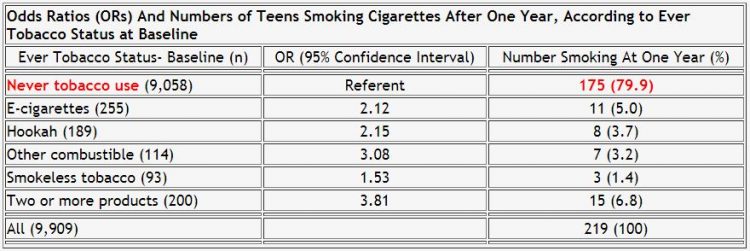Study Suggesting That Vaping Is a Gateway to Smoking Omits Critical Information
A recently-published study from the University of California San Francisco (UCSF) claiming that non-smoking adolescents who use e-cigarettes and alternative forms of tobacco are more likely to start smoking conventional cigarettes has been called out for failing to present important information.
 The study, co-authored by Benjamin W. Chaffee, an assistant professor at the UCSF School of Dentistry, and Stanton Glantz, director of the UCSF Center for Tobacco Control Research and Education and long-time anti-vaping crusader, analyzed data on 10,384 teens enrolled in the Population Assessment of Tobacco and Health (PATH) Survey in 2013-2014, and followed-up a year later. The goal of this research was to “estimate the longitudinal association between noncigarette tobacco use and subsequent cigarette smoking initiation among US youth.”
The study, co-authored by Benjamin W. Chaffee, an assistant professor at the UCSF School of Dentistry, and Stanton Glantz, director of the UCSF Center for Tobacco Control Research and Education and long-time anti-vaping crusader, analyzed data on 10,384 teens enrolled in the Population Assessment of Tobacco and Health (PATH) Survey in 2013-2014, and followed-up a year later. The goal of this research was to “estimate the longitudinal association between noncigarette tobacco use and subsequent cigarette smoking initiation among US youth.”
After analyzing data on the teenagers involved in the national PATH survey, researchers concluded that any form of tobacco – e-cigarettes, hookahs, smokeless tobacco, etc. – was associated with future smoking, especially when youths used more than one such alternative tobacco product.
“We found that teens who experimented with tobacco in any form were at greater risk of future smoking,” senior author Benjamin W. Chaffee said. In the last few years, research has focused on the potential of e-cigarettes to engage never-smoking adolescents in tobacco use. Our findings confirm that the use of the full range of tobacco products, including e-cigarettes, cigars, tobacco water pipes, and smokeless tobacco, is associated with greater odds of future cigarette smoking.”
Chaffee and Glantz found that nonsmoking teens who reported ever using electronic cigarettes or alternative forms of tobacco were 2 to 3 times more likely to be smoking cigarettes (at least on in the past 30 days) one year later than those who had never used any tobacco products. And teens who had ever tried two or more tobacco products were 3.81 times more likely to have started smoking tobacco cigarettes at the one year followup.
A press release from the University of California San Francisco states that “a year later, 469 adolescents (4.6 percent) said they’d tried a cigarette; and 219 (2.1 percent) had smoked a cigarette within the past 30 days. Smoking was higher among adolescents who used e-cigarettes (19.1 percent); hookah (18.3 percent); non-cigarette combustible tobacco (19.2 percent); or smokeless tobacco (18.8 percent).”
The two authors write that even if young people don’t move on to smoking cigarettes after experimenting with e-cigarettes and other tobacco products, “any tobacco use is harmful”, so they suggest “restricting flavors in e-cigarettes and raising the age of tobacco purchasing”.
As is always the case with negative research on electronic cigarettes, the results of this study were quickly picked up my major news outlets who used them as confirmation that vaping is a gateway to smoking. The authors had a role in making that happen as well, by omitting to provide critical information that puts their findings into perspective.
Luckily, Brad Rodu, a Professor of Medicine at the University of Louisville, was kind enough to explain how, by focusing on the odds ratio, Chaffee and Glantz omitted to specify that most of the cigarette-smoking teens at the one year followup came from the pool of participants who hadn’t used any form of tobacco at baseline.
Photo: Brad Rodu/Tobacco Truth
“Although teens trying other tobacco products were more likely to smoke, the majority of new smokers after one year came from the group that had not tried tobacco at baseline,” Prof. Rodu wrote on his blog. “After one year, 219 teens had smoked a cigarette in the past 30 days, and 175 of those (80%) had never used any tobacco product at baseline. Even though the odds of smoking were higher among youth who had tried other products, the number of smokers contributed by each of these groups was minuscule. (While actual survey numbers may vary slightly, the relative contributions of the groups will not change.)”
The “gateway theory” has already been debunked numerous times by several studies and surveys, and the declining number of smokers in the United States despite the growing popularity of vaping shows that vaping does not lead to smoking. However, anti-tobacco zealots continue to push the idea that e-cigarette users will eventually move on to smoking. I guess they think we just can’t resist that great tobacco smoke taste…

















